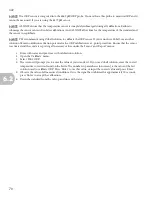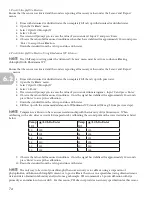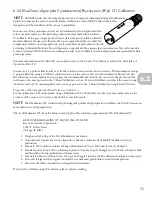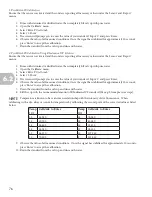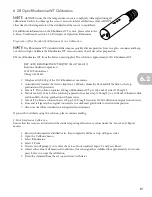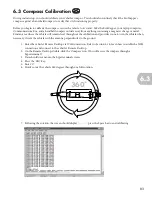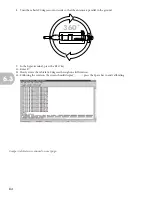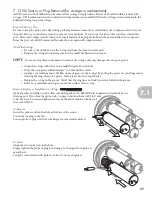
74
1-Point Chlorophyll Calibration
Ensure that the sensor is activated and the sonde is reporting all necessary values under the ‘Sensor’ and ‘Report’
menus.
1. Rinse with deionized or distilled water, then completely fill cal cup with deionized or distilled water.
2. Open the ‘Calibrate’ menu.
3. Select ‘Optic X-Chlorophyll.’
4. Select ‘1-Point.’
5. The screen will prompt you to enter the value of your standard. Input ‘0’ and press ‘Enter.’
6. Observe the value of all measured conditions, when they have stabilized for approximately 30 seconds press
‘Enter’ to accept the calibration.
7. Drain the standard from the cal cup and rinse with water.
2-Point Chlorophyll Calibration Using Rhodamine WT Solution.
The ‘ChlTempco’ setting under the ‘Advanced’>’Sensor’ menu must be set to zero when calibrating
chlorophyll with Rhodamine WT.
Ensure that the sensor is activated and the sonde is reporting all necessary values under the ‘Sensor’ and ‘Report’
menus.
1. Rinse with deionized or distilled water, then completely fill the cal cup with pure water.
2. Open the ‘Calibrate’ menu.
3. Select ‘Optic X-Chlorophyll.’
4. Select ‘2-Point.’
5. The screen will prompt you to enter the value of your standard in micrograms. Input ‘0’ and press ‘Enter.’
6. Observe the value of all measured conditions. Once the signal has stabilized for approximately 30 seconds
press ‘Enter’ to accept the calibration.
7. Drain the standard from the cal cup and rinse with water.
8. Fill the cup with the recommended amount of Rhodamine WT standard (0.5 mg/L from previous steps).
Temperature is known to have an inverse relationship with the intensity of dye fluorescence. When
calibrating with a dye, always account for temperature by calibrating the second point with a corrected value as listed
below.
Temp
(C)
μg/L Chl to Enter
Temp
(C)
μg/L Chl to Enter
30
100
18
122
28
103
16
126
26
106
14
131
24
110
12
136
22
113
10
140
20
118
8
144
9. Observe the value of all measured conditions. Once the signal has stabilized for approximately 30 seconds,
press ‘Enter’ to accept the calibration.
10. Drain the standard from the cal cup and rinse with water.
The only way to be sure of your chlorophyll sensor’s accuracy is to calibrate using a suspension of
phytoplankton with known chlorophyll content, or to post-calibrate the sensor in a spreadsheet using obtained sensor
data and data obtained in laboratory analysis from a grab sample. YSI recommends a 2-point calibration with dye
primarily as an indicator of sensor drift. For this reason, YSI does not provide an accuracy specification for this sensor.
NOTE
NOTE
NOTE
6.2











